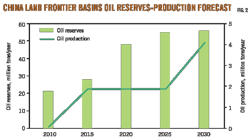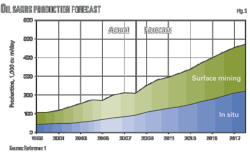OGJ's annual capital spending report shows that capital spending for all oil and gas projects in the US will decline 5% this year to $220 billion. Greater efficiency, slightly lower costs, and a rationalization of refining capacity will drive this decline.
Upstream spending will dominate all outlays this year, but by a larger margin than is typical. Many integrated companies plan to shrink their downstream spending from 2009, while some plan to increase their exploration and production expenditures.
Total spending for projects in Canada will climb 10% to $44 billion (Can.) this year. In Mexico, spending is set to increase about 5% from last year. Capital spending for oil and gas projects outside North America will grow this year as well.
US upstream spending
Spending in the US for upstream projects this year will total $195.667 billion, up from $193.5 billion a year ago. Included in this total are outlays for exploration, drilling, production, and offshore lease payments to the US Minerals Management Service.
Upstream costs peaked in 2008, driven by strong worldwide demand for commodities like steel and copper, as well as strong demand for skilled workers. As demand for these inputs declined as the global economic slowdown took hold, the costs of inputs eased, reducing the cost per oil and gas well drilled in 2009. OGJ forecasts that the cost per well drilled in the US will slide by a small margin this year, leading to a minimal hike in upstream spending for 2010.
Also, in shale plays and in nonshale plays, the number of days it takes some independent producers to drill a well has fallen dramatically, thereby reducing their costs per well and their total capital expenditures.
In the Bakken shale in North Dakota, for example, Enid, Okla.-based independent Continental Resources Inc. reduced its time to drill each well to 28 days in the first half of 2009 from 45 days in 2008. This led to a savings in cost per well since many input costs are leased by the day. Continental said that its drilling efficiency further improved for the second half of 2009, averaging about 24 days from spud to rig release.
OGJ's upstream spending outlook is based on its annual drilling forecast. The most recent drilling forecast called this year's US well completions to total 38,238 (OGJ, Jan. 18, 2010, p. 30). The number of well completions for 2009 was estimated at 37,062, down sharply from 2008, when the number of well completions was 52,097.
Based on a lower cost structure but greater number of well completions, drilling and exploration capital expenditures in the US this year are forecast to climb by almost 1% to $162.7 billion. Capital outlays for oil and gas production are forecast to increase at the same rate, totaling $30.9 billion.
Bonus payments that the MMS collects from lease sales for tracts on the Outer Continental Shelf comprise the third and final component of US upstream spending. OGJ projects that the total bonus on leased tracts this year will be $2 billion. Two Gulf of Mexico sales during 2009 generated $801 million in bonus payments, while four sales in 2008 generated $6.9 billion in payments to the MMS.
As of press time, the MMS has four lease sales scheduled for 2010. Two of these will offer tracts in the Gulf of Mexico. A sale on Mar. 17 will offer tracts in the central gulf, and a planned sale on Aug. 18 will offer tracts in the western gulf. The other two sales planned this year are for Alaska's Chukchi and Beaufort seas.
US downstream spending
Year-on-year changes in downstream spending will be mixed in 2010. OGJ forecasts that capital expenditures at US refineries will decline to $5.3 billion from $10.1 billion a year ago but that petrochemical outlays will climb to $80 million from $50 million.
Refining and petrochemical operations in the US have contracted along with widespread weakness in demand for transportation fuels and other petroleum products since the beginning of the recent recession, resulting is excess spare refining capacity. Since 2008, refining capacity has been reduced through closures in North America, Japan, Europe, and Aruba.
Philadelphia refiner Sunoco Inc. permanently closed its Eagle Point plant in New Jersey, citing weak demand for refined products and unfavorable market conditions. Sunoco idled Eagle Point in October 2009. And in February, Sunoco reached an agreement to sell its chemical operations to Brazilian petrochemical and resin producer Braskem SA.
Valero Energy Corp., San Antonio, announced in November 2009 that it would permanently shut down its 190,000 b/d Delaware City refinery due to financial losses caused by very poor economic conditions, significant capital spending requirements, and high operating costs.
Meanwhile, Calgary-based Husky Energy Inc. announced that its 2010 downstream capital program, set at $450 million (Can.), will focus on engineering and maintenance work at its refineries in Lima, Ohio, and the BP PLC-Husky refinery in Toledo, Ohio. Husky also said that some of this amount will go toward continuous improvement and maintenance work that has been planned for its ethanol, refining, and retail operations in Canada.
Pipelines, other US outlays
Capital spending for pipelines and compressor stations in the US is set to drop this year following an increase in 2009. Pipeline construction will contract for both crude and products lines and gas lines, according to OGJ's most recent Worldwide Pipeline Construction report (OGJ, Feb. 15, 2010, p. 39).
This report revealed that plans call for a total of 926 miles of natural gas pipelines to be completed in the US this year, down from 4,000 miles of construction completed last year. OGJ estimates that capital spending for this year's gas lines will total $2.58 billion.
Plans also call for a total of almost 2,600 miles of crude and products pipelines to be completed during 2010, compared to last year's 3,045 miles. Spending for the lines this year will decline 15% to $7.7 billion.
Capital expenditures this year for other transportation projects in the US will rebound 13% after dropping 30% last year. Marketing outlays also will climb following a down year in 2009. LNG project spending will be little changed from last year.
E&P, Canadian oil sands
Much of the growth in capital expenditures in Canada this year will be in outlays for oil sands, although upstream and downstream spending also will climb from last year.
Capital outlays for conventional oil and gas exploration, drilling, and production in Canada will increase 8% this year. OGJ's drilling forecast calls for a total of 8,618 oil and gas wells to be completed this year in Canada.
This follows a 39% contraction in spending a year ago, as the number of well completions sank to just fewer than 8,000. This was down sharply from 2008 when the number of well completions totaled 13,118, according to the Canadian Association of Petroleum Producers.
OGJ forecasts that oil sands capital expenditures, including outlays for in-situ, mining, and upgrading, will increase by 10%, rebounding from last year's 17% decline. The most recent figures from CAPP reported that oil sands spending in 2008 totaled $18.113 billion (Can.).
After last year's pullback, a handful of large oil sands projects are getting the go-ahead this year. Alberta's Energy Resources and Conservation Board has approved the Husky-BP Sunrise oil sands project. Also, ConocoPhillips will start construction this year of the second phase of its steam-assisted gravity drainage Surmont project.
Canadian Natural Resources Ltd., Calgary, announced that its total 2010 capital budget will increase 26% over 2009, with more than 80% allocated to the development of its crude oil assets. Spending at CNR's Horizon Oil Sands project for the coming year is focused on Tranche 2 of the second and third phases and includes spending to develop a detailed cost estimate for future expansions.
Nexen Inc., Calgary, reported that most of its capital spending this year—$1.8 billion (Can.)—is allocated toward the development of conventional resources, while $400 million (Can.) is budgeted for oil sands. Another $200 million (Can.) is set to be spent on shale gas projects.
Nexen's $2.5 billion (Can.) capital spending budget for 2010 assumes a $70/bbl average price of West Texas Intermediate crude and an average New York Mercantile Exchange gas price of $5.50/MMbtu.
Suncor Energy Inc., Calgary, plans $5.5 billion (Can.) in capital spending this year. About $1.5 billion (Can.) will be directed toward growth-project funding, mostly for the Firebag Stage 3 in-situ oil sands expansion.
Other outlays in Canada
Natural gas pipeline and compressor station spending in Canada will swell this year to $1.67 billion from $33 million last year. But expenditures for new crude and products pipelines and compressor stations will shrink 40% as projects are completed.
OGJ's most recent Worldwide Pipeline Construction report shows that 627 miles of gas pipelines are due to be completed this year in Canada vs. just 34 miles of construction last year. Plans also call for the construction of 409 miles of crude and products lines this year compared to 504 miles a year ago in Canada.
Enbridge Inc., Calgary, made an announcement on Feb. 3 about its liquids pipelines, saying that the company will move its two largest ever projects into day-to-day operations this year, as the Canadian and US segments of the Alberta Clipper expansion project are expected to be placed in service on Apr. 1. Also, Enbridge's Southern Lights line is on budget and on schedule to be in service in this year's second half.
As in the US, capital spending in Canada at refineries will decline this year, while spending for petrochemicals rebounds a bit. Capital budgets also call for an increase in marketing and all other categories this year following an especially weak 2009.
Spending elsewhere
Spending in Mexico for oil and gas projects will climb this year, according to figures released last December by Petroleos Mexicanos. The company estimates that this year's investment budget will total $19.1 billion, up from $18.1 billion last year.
Pemex said that 84% of this year's expenditures will be directed toward upstream operations, while 12% will be spent in refining projects. The remainder will be directed toward petrochemical and other projects.
Upstream spending outside North America will climb to $337 billion this year from $305 billion, according to the most recent Barclays Capital Original E&P Spending Survey, released Dec. 16, 2009.
Projects to advance the production of petrochemicals and fuels will dominate downstream capital spending in the near term outside North America, with a slate of refineries planned for construction in Asia. And work continues on Royal Dutch Shell PLC's Pearl gas-to-liquids plant in Qatar's Ras Laffan Industrial City. This project launched in July 2006.
Also, Qatar Petroleum and ExxonMobil Chemical Qatar Ltd. have agreed to move forward on the development of a petrochemical complex at Ras Laffan that would include the world's largest steam cracker (OGJ Online, Jan. 7, 2010).
The proposed complex, which would include a 1.6 million-tonne/year steam cracker, two 650,000-tpy gas-phase polyethylene plants, and a 700,000-tpy ethylene glycol plant, would start up in late 2015.
More Oil & Gas Journal Current Issue Articles
More Oil & Gas Journal Archives Issue Articles
View Oil and Gas Articles on PennEnergy.com


